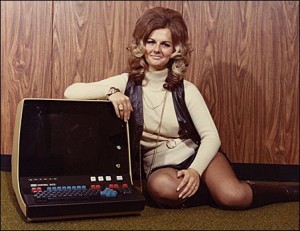Editor’s Note: This guest post was written by Sarah Paiji, co-founder and CEO of Snapette, a mobile fashion shopping startup that drives users to nearby stores. She is an alumni of 500 Startups accelerator and dropped out of Harvard Business School to work on Snapette full-time with her co-founder Jinhee Ahn Kim. Snapette Director of Marketing Sanby Lee also contributed to the post.
When it comes to fashion, women have embraced products that were originally designed for men. Flip through any J.Crew catalog and you’ll encounter the Boyfriend Jean, Boyfriend Blazer, unisex ankle boots, and of course the classic men’s shirt paired with skinny jeans.
When it comes to tech? Not so much. In the predominantly male tech world, products are usually, by default, designed by men — for men. However, women have different design preferences and needs, with research showing that men and women do indeed use the Web and social media in different ways.
Designers and developers may be missing out on a huge opportunity by overlooking the gender of users when creating products. Women control 80 percent of consumer spending and drive the majority of user activity on many of the largest social networks. The recent success of startups driven by female users such as Gilt Groupe, Learnvest, InDinero, OneKingsLane, and countless social gaming apps show that there is value in focusing specifically on the female consumer.
So if a large portion of your customer base is women (or you’d like it to be) how do you design for them? As women who are developing products for other women, here’s what we’ve learned from our experience:
1. Don’t Be Afraid To Go Pink.
We don’t mean that your product literally has to be pink. However, you shouldn’t be afraid to make a product that is only for women, and to signal this through your aesthetic and branding. For our mobile shopping app, we chose a name and color scheme that was decidedly feminine. We had men complain that they didn’t feel comfortable using the app, or posting in a community dominated by women.
But that’s the point — we didn’t want men as our initial audience. Given that our product is a social shopping app that relies on crowdsourcing and strong community, our focus on “just women” has helped us create a targeted and streamlined user experience. Women see photos posted by users similar to them, thus increasing the likelihood they find products they enjoy and that are relevant.
2. Resist Feature Overload.
Keeping it simple is a cornerstone of good design for any gender, but it’s even more crucial when it comes to products targeting women. Women are less likely to spend time hunting around or exploring new features because they may be juggling other tasks that require their time and attention. For example, we have found that many of our users are moms who would browse the app while running errands, waiting in line at the grocery store, or watching their kids play softball.
Working women still do twice the amount of chores and three times the amount of childcare in their households than working men. For these women, adding new features may go unnoticed, and may actually turn them off by taking up more of their time.
3. Find The Key Influencers.
For marketing to women, social sharing is even more important than for men. For example, loyalty platform Endorse acquired 15,000 beta users, almost 90 percent of which were women, by recruiting just five women initially to spread the word among their friends.
Jewelry startup Stella & Dot has built its business by having their existing customer base hold private parties during which women encourage their friends to buy products, reminiscent of Avon women and similar to Tupperware parties of the past. Don’t underestimate the power of female social networks, especially offline ones — with 92 percent of women sharing information about shopping deals to their friends.
4. Enable Discovery.
Women are valuable consumers because they are more open to trying new things, whereas men tend to find one thing they like and stick with it. Research from Wharton Business School backs this up with data: Women view the shopping experience itself as a form of entertainment and an enjoyable way to find new products, whereas men are focused on getting what they need, then getting out.
Startups like Birchbox and Rent the Runway have become popular among women by allowing them to experience a large variety of merchandise at minimal cost, replicating the offline experience of wandering through a department store and trying on clothes or getting perfume samples.
5. Have Women On Your Team.
We’re not saying that men can’t design for women, especially with help from interviewing women, doing surveys, and learning their needs. However, if your company is a startup, your time and resources are always limited, and you don’t always have the ability to do extensive user research.
It helps to start with yourself as the target user, and the easiest way to think like a woman is to be one. In designing Snapette, it’s been incredibly useful and efficient to be able to draw on our own personal experiences — anything from deciding which shoe to feature in a marketing campaign to deciding whether a new feature is useful.
What do you think? Have you seen great examples of tech designed for women? Would you be turned off by anything pink no matter how well it was designed? Tell us your thoughts.
Image credit: Ruth Graham/TheGrindStone
